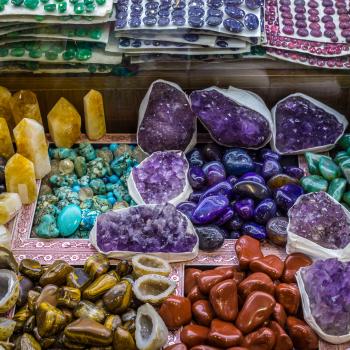Trading Information about Minerals Through Trading Cards

- Preview |
- Standards |
- Resources & Preparation |
- Instructional Plan |
- Related Resources |
- Comments
Overview
In this lesson, students research properties of minerals and then demonstrate their understanding of the information by producing creative trading cards using the easy and engaging Trading Cards Mobile App. Using the mobile devices' cameras, the students include a photo that illustrates the use of their minerals in their lives. Then the students share their trading cards, which can be printed or projected on a whiteboard, thus building the class's knowledge about minerals through this fun, interactive app.
Featured Resources
- Trading Cards Mobile App: Students will use this free mobile app from ReadWriteThink to create trading cards that illustrate the properties of minerals.
- Mineralogy 4 Kids: Students will use this website to explore the terminology used to refer to the properties of minerals.
From Theory to Practice
The use of in the Trading Cards Mobile App classroom supports the NCTE Definition of 21st Century Literacies. According to this definition, “Active, successful participants in this 21st century global society must be able to develop proficiency and fluency with the tools of technology” and therefore, exposure to mobile apps, such as Trading Cards is a vital part of the classroom experience. Furthermore, as Xu, Perkins, and Zunich point out, the familiar trading card format to express their knowledge may motivate reluctant or struggling learners.
Common Core Standards
This resource has been aligned to the Common Core State Standards for states in which they have been adopted. If a state does not appear in the drop-down, CCSS alignments are forthcoming.
State Standards
This lesson has been aligned to standards in the following states. If a state does not appear in the drop-down, standard alignments are not currently available for that state.
NCTE/IRA National Standards for the English Language Arts
- 1. Students read a wide range of print and nonprint texts to build an understanding of texts, of themselves, and of the cultures of the United States and the world; to acquire new information; to respond to the needs and demands of society and the workplace; and for personal fulfillment. Among these texts are fiction and nonfiction, classic and contemporary works.
- 3. Students apply a wide range of strategies to comprehend, interpret, evaluate, and appreciate texts. They draw on their prior experience, their interactions with other readers and writers, their knowledge of word meaning and of other texts, their word identification strategies, and their understanding of textual features (e.g., sound-letter correspondence, sentence structure, context, graphics).
- 4. Students adjust their use of spoken, written, and visual language (e.g., conventions, style, vocabulary) to communicate effectively with a variety of audiences and for different purposes.
- 5. Students employ a wide range of strategies as they write and use different writing process elements appropriately to communicate with different audiences for a variety of purposes.
- 6. Students apply knowledge of language structure, language conventions (e.g., spelling and punctuation), media techniques, figurative language, and genre to create, critique, and discuss print and nonprint texts.
- 7. Students conduct research on issues and interests by generating ideas and questions, and by posing problems. They gather, evaluate, and synthesize data from a variety of sources (e.g., print and nonprint texts, artifacts, people) to communicate their discoveries in ways that suit their purpose and audience.
- 8. Students use a variety of technological and information resources (e.g., libraries, databases, computer networks, video) to gather and synthesize information and to create and communicate knowledge.
- 11. Students participate as knowledgeable, reflective, creative, and critical members of a variety of literacy communities.
- 12. Students use spoken, written, and visual language to accomplish their own purposes (e.g., for learning, enjoyment, persuasion, and the exchange of information).
Materials and Technology
- Mobile Devices
- Computer connected to LCD projector
- Printer and/or adapter to connect tablet to LCD projector
- Books on minerals (see printouts)
Printouts
Websites
This webpage is part of Geology.com and provides information in easy to read charts about the properties of individual minerals.
This website has in depth information for several minerals. It will be a good site for students to find interesting facts.
Students will find minerals listed alphabetically and discover several of the properties and uses at this website.
This website provides several uses for the most common minerals.
Students will use this website to explore the terminology used to refer to the properties of minerals.
Preparation
- Download the Trading Cards Mobile App on the devices the students will use.
- Make one copy for each student of the following print-outs: Let’s Learn about Mineral Properties, Notes for the Trading Card, Mineral Trading Card Rubric, and List of Minerals.
- If you have a class wiki or website, link the websites from the Websites for Mineral Trading Cards. If not, then make one copy per student of this print-out, too.
- Prepare a trading card for a mineral to show the students or use the print-out Trading Card Sample.
- Read the information on the Trading Cards Mobile App and familiarize yourself with the app. This lesson will use the template for an object.
- Arrange to have books from the Suggested Books printout available to students.
Student Objectives
Students will
- create a trading card after researching a mineral.
- apply the terminology of mineral properties to a particular mineral.
- connect the uses of minerals to their everyday lives.
Session One
- Project the Venn Diagram, 2 Circles printout and as a class complete the diagram to show the differences and similarities between rocks and minerals. Be sure the following facts are discussed and solicit students for more ideas.
- Minerals have a definite chemical composition while rocks do not.
- Minerals are usually the same colors while rocks have more variety.
- Minerals have definite shape (crystals) while rocks do not.
- Rocks are formed by two or more minerals while minerals are not made up of rocks.
- Both are found in nature.
- Both have specific uses that help our world.
- Minerals have specific properties that aid in their identification while identification of rocks relies on appearance and finding what minerals the rocks contain.
- Explain to the class after learning about mineral properties, they will each individually research a mineral. Project the Trading Card Sample or the one you have created. Explain to the students that they will share their research with trading cards such as the example.
- Using the mobile devices or computers connected to the Internet, have students work in pairs to answer the questions on the printout Let’s Learn about Mineral Properties using the website Mineralogy 4 Kids. As students work through the printout, assist those who have trouble finding the answers.
- After all have completed the printout, go through the answers together and have students correct anything they have wrong.
Session Two
- Again project the example trading card. Hand out the printout Notes for the Trading Card. Discuss the following:
- Review the terminology used to describe mineral properties.
- Note where the researched information appears on the trading card as shown in the parentheses.
- Make sure students see the connection between the photo and the last category.
- Hand out the Mineral Trading Card Rubric and evaluate the trading card together. Point out to the students that their information will be written in complete sentences as evaluated on the rubric.
- Hand out the printout List of Minerals or project the list. Have each student choose which mineral he/she would like to research.
- Allow time for students to use either the mobile devices or computers connected to the Internet as well as books from the Suggested Books list to complete Notes for the Trading Cards. As students work, assist those who have trouble finding information. Observe student behavior and time on task as that is part of the rubric.
- For the next session, assign students to bring items that they might want to photograph for how they are connected to their individual minerals.
Session Three
- Check that all students have completed their printout Notes for the Trading Card. Allow those that have not completed the notes additional time to finish.
- If possible, connect a mobile device to a projector and model for the students how to move their notes to the Trading Cards Mobile App. Instruct the students on how to use the camera on the mobile devices to photograph items they will use to illustrate their connections to their minerals.
- Tell students to take their photos first and then to use the app to create their trading cards. As students work, assist those who have trouble using the mobile app and/or using the cameras.
- Once the trading cards are completed, the easiest way to share the cards in the next session is to use an adapter to connect the mobile devices to a projector. If that is not possible, students can print copies if a wireless printer is available. If not, students can e-mail their trading cards to the teacher who can download and print the trading cards.
- Observe student behavior and time on task as that is part of the rubric.
Session Four
- Have the students share their trading cards either using a hard copy or a projector.
- After each presentation, ask students for additional ways that they use these minerals in their daily lives based on what was presented.
Extensions
- Print the trading cards and create a class mineral scrapbook.
- Ask students to bring in other example images about the minerals that were presented in the class. Post these images on a bulletin board in the classroom.
- Have students e-mail their trading cards to you and upload them to the class wiki or website so that all can view their work.
Student Assessment / Reflections
Possible student assessments include:
- Use the Mineral Trading Card Rubric to evaluate student work.
- Keep notes on students’ time on task.
- Ask the students to explain the relationship between the images they choose and their connections to the minerals.
- Ask students to complete the following statements:
From this project I learned ___________________________.
This project could have been improved by ___________________.

Add new comment